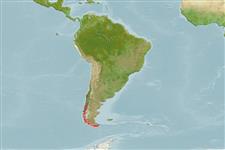Common names from other countries
Environment: milieu / climate zone / depth range / distribution range
Ecologia
; intervalo de profundidade 0 - 33 m (Ref. 87801). Subtropical
Southeast Pacific: Probably endemic to Chile.
Length at first maturity / Tamanho / Peso / Idade
Maturity: Lm ? range ? - ? cm
It is found on rocks, often in the coralline red algae zone, from intertidal areas to 33 meters in depth (Ref. 87801).
Life cycle and mating behavior
Maturidade | Reprodução | Desova | Ovos | Fecundidade | Larvas
Members of the class Polyplacophora are mostly gonochoric. Life cycle: Eggs hatch into lecitotrophic planktonic trocophore larvae (no veliger stage) which later metamorphose and settle on the bottom as young adults.
Rosenberg, G. 2009. (Ref. 83435)
Status na Lista Vermelha da IUCN (Ref. 130435)
Status no CITES (Ref. 108899)
Not Evaluated
Not Evaluated
Uso pelos humanos
| FishSource |
Ferramentas
Mais informação
Idade/Tamanho
Crescimento
Comprimento-peso
Comprimento-comprimento
Morfologia
Larvas
Abundância
Fontes da internet
Estimates based on models
Categoria de preço
Unknown.
